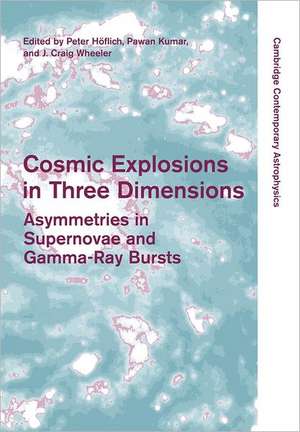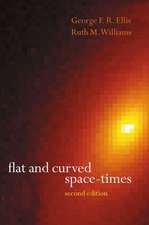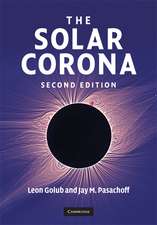Cosmic Explosions in Three Dimensions: Asymmetries in Supernovae and Gamma-Ray Bursts: Cambridge Contemporary Astrophysics
Editat de Peter Höflich, Pawan Kumar, J. Craig Wheeleren Limba Engleză Paperback – 17 aug 2011
| Toate formatele și edițiile | Preț | Express |
|---|---|---|
| Paperback (1) | 451.75 lei 6-8 săpt. | |
| Cambridge University Press – 17 aug 2011 | 451.75 lei 6-8 săpt. | |
| Hardback (1) | 1062.78 lei 6-8 săpt. | |
| Cambridge University Press – 15 dec 2004 | 1062.78 lei 6-8 săpt. |
Preț: 451.75 lei
Nou
Puncte Express: 678
Preț estimativ în valută:
86.45€ • 89.93$ • 71.37£
86.45€ • 89.93$ • 71.37£
Carte tipărită la comandă
Livrare economică 14-28 aprilie
Preluare comenzi: 021 569.72.76
Specificații
ISBN-13: 9781107403116
ISBN-10: 1107403111
Pagini: 392
Dimensiuni: 170 x 244 x 21 mm
Greutate: 0.62 kg
Editura: Cambridge University Press
Colecția Cambridge University Press
Seria Cambridge Contemporary Astrophysics
Locul publicării:New York, United States
ISBN-10: 1107403111
Pagini: 392
Dimensiuni: 170 x 244 x 21 mm
Greutate: 0.62 kg
Editura: Cambridge University Press
Colecția Cambridge University Press
Seria Cambridge Contemporary Astrophysics
Locul publicării:New York, United States
Cuprins
Introduction: 3-D Explosions: a meditation on rotation (and magnetic fields) J. C. Wheeler; Part I. Supernovae: Observations Today: 1. Supernova explosions: lessons from spectropolarimetry L. Wang; 2. Spectropolarimetric observations of Supernovae A. Filippenko and D. C. Leonard; 3. Observed and physical properties of type II plateau supernovae M. Hamuy; 4. SN1997B and the different types of Type Ic Supernovae A. Clocchiatti, B. Leibundgut, J. Spyromilio, S. Benetti, E. Cappelaro, M. Turatto and M. Phillips; 5. Near-infrared spectroscopy of stripped-envelope Supernovae C. L. Gerardy, R. A. Fesen, G. H. Marion, P. Hoeflich and J. C. Wheeler; 6. Morphology of Supernovae remnants R. Fesen; 7. The evolution of Supernova remnants in the winds of massive stars V. Dwarkadas; 8. Types for the galactic Supernovae B. E. Schaefer; Part II. Theory of Thermonuclear Supernovae: 9. Semi-steady burning evolutionary sequences for CAL 83 and CAL 87: supersoft X-ray binaries are Supernovae Ia progenitors S. Starrfield, F. X. Timmes, W. R. Hix, E. M. Sion, W. M. Sparks and S. Dwyer; 10. Type Ia Supernovae progenitors: effects of the spin-up of the white dwarfs S.-C. Yoon and N. Langer; 11. Terrestrial combustion: feedback to the stars E. S. Oran; 12. Non-spherical delayed detonations E. Livne; 13. Numerical simulations of Type Ia Supernovae: deflagrations and detonations V. N. Gamezo, A. M. Khokhlov and E. S. Oran; 14. Type Ia Supernovae: spectroscopic surprises D. Branch; 15. Aspherity effects in Supernovae P. Hoeflich, C. Gerardy and R. Quimby; 16. Broad light curve SneIa: asphericity or something else? A. Howell and P. Nugent; 17. Synthetic spectrum methods for 3-D SN models R. Thomas; 18. A hole in Ia' spectroscopic and polarimetric signatures of SN Ia asymmetry due to a companion star D. Kasen; 19. Hunting for the signatures of 3-D explosions with 1-D synthetic spectra E. Lentz, E. Baron and P. H. Hauschildt; 20. On the variation of the peak luminosity of Type Ia J. W. Truran, E. X. Timmes and E. F. Brown; Part III. Theory of Core Collapse Supernovae: 21. Rotation of core collapse progenitors: single and binary stars N. Langer; 22. Large scale convection and the convective Supernova mechanism S. Colgate and M. E. Herant; 23. Topics in core-collapse Supernova A. Burrows, C. D. Ott and C. Meakin; 24. MHD Supernova jets: the missing link D. Meier and M. Nakamura; 25. Effects of super strong magnetic fields in core collapse Supernovae I. S. Akiyama; 26. Non radial instability of stalled accretion shocks advective-acoustic cycle T. Foglizzo and P. Galletti; 27. Asymmetry effects in Hypernovae K. Maeda, K. Nomoto, J. Deng and P.A. Mazzali; 28. Turbulent MHD jet collimation and thermal driving P. T. Williams; Part IV. Magnetars, N-Stars, Pulsars: 29. Supernova remnants and pulsar wind nebulae R. Chevalier; 30. X-Ray signatures of Supernovae D. Swartz; 31. Asymmetric Supernovae and Neutron Star Kicks D. Lai and D. Q. Lamb; 32. Triggers of magnetar outbursts R. Duncan; 33. Turbulent MHD Jet Collimation and Thermal Driving P. Williams; 34. The interplay between nuclear electron capture and fluid dynamics in core collapse Supernovae W. R. Hix, O. E. B. Messer and A. Mezzacappa; Part V. Gamma-Ray Bursts: 35. GRB 021004 and Gamma-ray burst distances B. E. Schaefer; 36. Gamma-ray bursts as a laboratory for the study of Type Ic Supernovae D. Q. Lamb, T. Q. Donaghy and C. Graziani; 37. The diversity of cosmic explosions: Gamma-ray bursts and Type Ib/c Supernovae E. Berger; 38. A GRB simulation using 3D relativistic hydrodynamics J. Cannizo, N. Gehrels and E. T. Vishniac; 39. The first direct link in the Supernova/GRB connection: GRB 030329 and SN 2003dh T. Matheson; Part VI. Summary: 40. Three-dimensional explosions C. Wheeler.
Recenzii
Review of the hardback: '… the in-depth reviews of the volume … make it a valuable resource for graduate students and researchers.' The Observatory
Descriere
This volume marks the transition to a fresh paradigm in the study of stellar explosions.





















